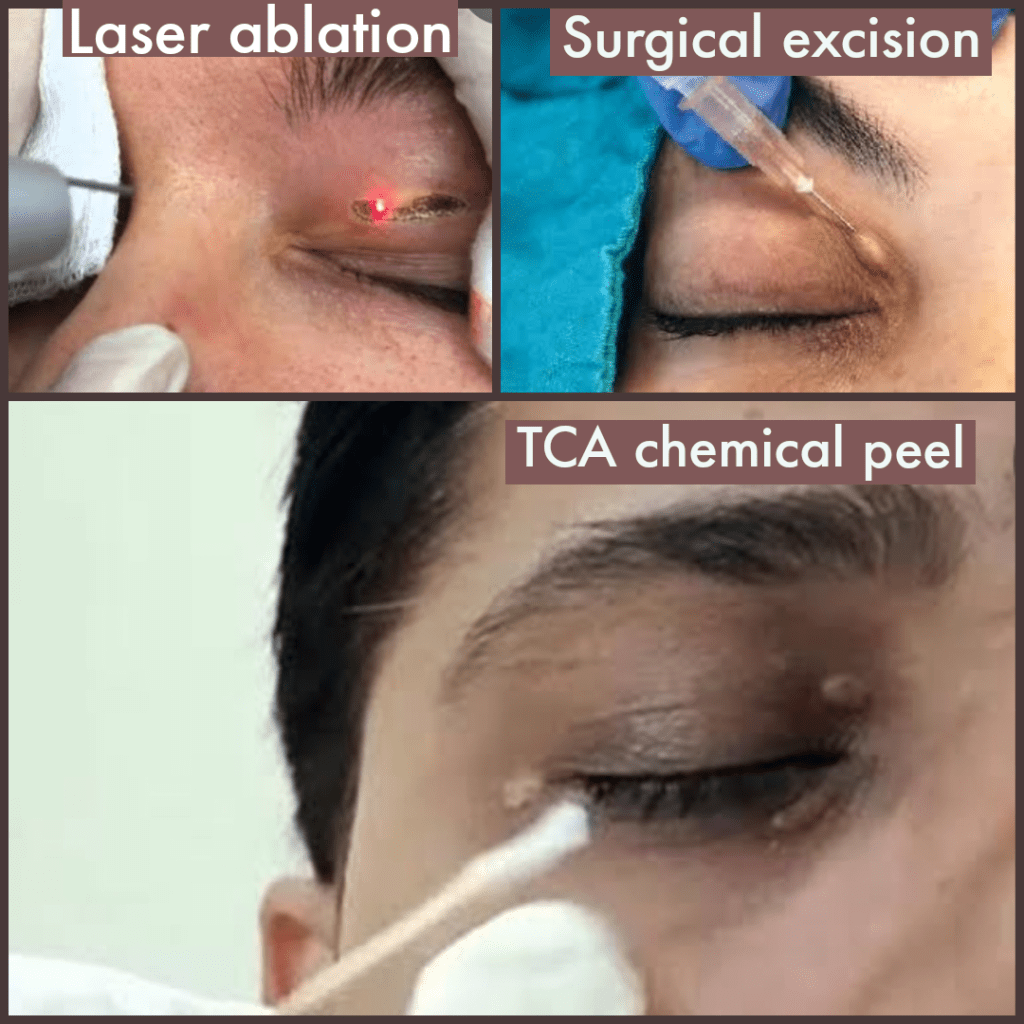What does the term “xanthelasma palpebrarum” mean?
The term Xanthelasma comes from the Greek words “xanthos,” which means blond or yellow, and “elasma,” which means plate. The Latin word “palpebrarum” means “of the eyelid.”
What is Xanthelasma palpebrarum (XP)?

A benign skin condition called xanthelasma palpebrarum or XP causes soft, yellow, painless lesions to develop on the eyelids, most frequently on the upper eyelid on the nasal side. It may be single or multiple.
Typically, it is a cholesterol deposit. The frequency of the condition is higher among females than males, at 1.1 percent against 0.3 percent. In most cases, the occurrence occurs between the ages of 35 and 55.
What causes Xanthelasma palpebrarum (XP)?
High blood cholesterol is present in 50% of patients with Xanthelasma palpaebrarum. But individuals may have XP even with normal lipid profile.
These conditions include:
- Diabetes
- Thyroid dysfunction
- Erythroderma
- Inflamed skin conditions
- Atopic dermatitis
- Fattening, unhealthy diet leading to weight gain
- Family history
Will it resolve on its own?
Once xanthelasma has formed, it won’t spontaneously go away. Instead, it will stay the same size or grow more prominent. The majority of people seek medical attention due to aesthetic issues.
What should I do if I develop xanthelasma?
The only concern with xanthelasma is its appearance; otherwise, it is a benign condition and will not harm anyone. However, a person with xanthelasma must visit a doctor to have blood tests for issues like cholesterol, thyroid function, blood sugar, etc. It might predict systemic atherosclerosis, myocardial infarction, or ischemic heart disease.
WHAT ARE THE TREATMENT OPTIONS FOR XANTHELASMA?

It is necessary to determine the cause of XP, treat it, and incorporate certain lifestyle changes in order to manage it. However, this will not reduce the appearance of XP, but can help prevent further occurrences.
These lifestyle modifications are essential, especially for those suffering from diseases such as hyperlipidemia, diabetes, and obesity.
- Incorporating nutrient-dense foods into your diet, such as green leafy vegetables, sweet potatoes, fresh seasonal fruits, nuts, and seeds.
- Controlling blood pressure and cholesterol requires a balanced diet approved by the dietician that includes unprocessed, fresh foods that are low in salt, sugar, and saturated fat.
- Exercising regularly and managing healthy weight.
Removal techniques:
Once xanthelasmas have formed, a low-fat diet and medications have little impact on its appearance. For those with XP who have cosmetic concerns, the removal of the lesion using techniques like surgical excision, laser, chemical peel, etc can be done.
1. Liquid nitrogen cryotherapy:
This procedure involves applying nitrogen cryoprobe to the lesion. This causes blood vessels to constrict and microthrombi formation resulting in tissue death.
It is possible that swelling, pus, or blisters will develop as a result of the inflammatory reaction.
2. SURGICAL ExcisiON:
In the past, surgical excision has frequently produced excellent cosmetic results. This procedure is performed under local anesthesia. Next, the extra skin is trimmed and the gap is sutured. The procedure may require skin grafts or flaps if it is extremely large.
3. Chemical peeling with TCA (trichloroacetic acid)

Trichloroacetic acid penetrates the skin and causes cell death by denaturing proteins and coagulating them. Since this substance is acidic, it is essential to apply petrolatum ointment to the sensitive areas of the eyes before using it.
TCA is most frequently used topically at a concentration of 70%. Cold water is then applied to the area, followed by antibiotic ointment and sunscreen.
Depending on the size and response, the treatment involves one or more sessions. TCA is particularly effective in small lesions.
4. Laser ablation
There are a variety of lasers that can be used to treat lesions such as carbon dioxide, erbium, pulsed dye, argon, and Nd:YAG lasers.
The most effective ablative laser is CO2. The targeted use of CO2 lasers causes the vaporization of water within cells, which results in the layer-by-layer ablation of the skin.
Pain, erythema, pigmentations, scars, and eye injuries are all side effects of laser therapy.
5. Radiofrequency:
This procedure uses low-voltage radio-frequency (RF) for tissue ablation. The treatment has shown to be effective, especially when lesions are numerous, have hazy borders, and are close to the eyes.. Compared to other modalities, it is very safe, but it is less effective and may be expensive.
What is the main DISADVANTAGE of the therapy?
Regardless of the mode of treatment, the primary issue or disadvantage of these treatments is recurrence.
It is possible to reduce the chance of recurrence by maintaining a healthy lifestyle, taking medications as prescribed, and scheduling routine blood and health tests.
Some therapeutic approaches have been compared, such as those undergoing CO2 laser ablation and those receiving TCA chemical peels.
Both modalities were effective for treating clinically mild lesions. The laser group had complete clearance in every patient, as opposed to the TCA group, which had a complete clearance rate of only 56%. Unfortunately, both treatment modalities demonstrated recurrence, with a recurrence rate more for TCA.
Additionally, the CO2 laser showed the best treatment results for severe lesions due to its extendable coagulative effect.
QUICK SUMMARY
The disfigurement caused by XP can be extremely distressing to an individual, even though it is regarded as benign and safe. In addition, they may be a sign of underlying diseases such as high cholesterol, diabetes, or a dysfunctional thyroid. Therefore, patients should be checked for these conditions and monitored for any associated morbidities. There are many removal techniques for treating XP. Unfortunately, recurrence is common with all therapeutic modalities.
